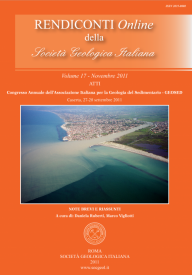
Potential tsunami reconstruction from submarine landslide in Bay of Naples, Southern Tyrrhenian sea
Di Fiore V. (*), Aiello G. (*) & D'Argenio B. (*)
(*) Istituto per l'Ambiente Marino Costiero, CNR, Calata Porta di Massa, Porto di Napoli, 80133 Napoli. E-mail: vincenzo.di fiore@cnr.it; gemma.aiello@iamc.cnr.it; b.dargenio@iamc.cnr.it
Volume: 17/2011
Pages: 89-93
Abstract
A mathematical model for tsunami waves and run-up generating by submarine landslides in the canyons of the Bay of Naples (Magnaghi-Dohrn canyon system) is here discussed. The morpho-bathymetry and submarine gravity instability of the Naples canyons has been studied through the interpretation of a high resolution DEM. The Dohrn and Magnaghi canyons are controlled by the interaction between volcanic activity (Phlegrean Fields and Ischia and Procida volcanic complexes) and sedimentary processes related to Sarno-Sebeto rivers. The abrupt termination of the Ammontatura channel (prolonging of the Dohrn western branch on the Naples outer shelf) against the Nisida volcanic bank was older or contemporaneous with the eruption of the Neapolitain Yellow Tuff (NYT). This suggests that the Dohrn canyon system is older than the NYT, which forms the main basis of the Naples town. This implies that most part of the canyon system activity is older than 11-12 ky B.P., age of the NYT. Despite the canyon system is actually inactive, the main submarine instabilities have been identified and mapped around the Dohrn western branch, from the head to the middle of the branch, on the continental slope southwards of the Magnaghi canyon and on the north-western slope of the Banco di Fuori carbonatic high. The results of a simulation of failures in the above source areas show that the amplitude of wave run-up, expressed in terms of the sea fl oor depth percentage, may range up to 2.5 % of the water depth.
Keywords
Get Full Text